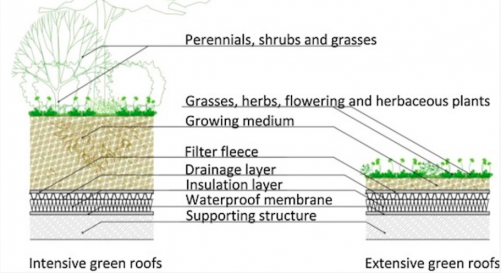Biophilic design has been a hot topic in the construction industry this year. There is a focus on bringing the natural environment inside so that we can satisfy our innate need for a connection with nature. But what isn’t emphasised in this design strategy are other ways of implementing nature in the build and renovation of your home.
There are a number of health benefits associated with bringing nature indoors; reduced stress, lower blood pressure and increased productivity to name a few. These benefits help individuals living in the home, but what about trying to benefit the outside environment and even the structure of the home? The world is faced with changing climate and issues brought upon by human industrialisation, the importance of green technologies has never been more important. As part of this, green roofs have emerged in an effort to reduce our impact on the environment. It is another opportunity to maximise design techniques for a space that would otherwise have minimal use.
What is a Green Roof?
A green roof is a roof top that is planted with native plants, shrubs, grasses, herbs, flowering and herbaceous plants. The roof has some sort of plant life growing. It is often used to compensate for the destruction of vegetation that occurred because of the construction of the building. Green roofs can be categorised into two types; extensive and intensive. They differ in the depth of soil, root structures and plant types. Intensive green roofs can grow a variety of plants due to its deeper underlying layer. Plants that require intensive maintenance including trees shrubs and perennials are categorised as intensive green roofs. In contrast, extensive roofs require less maintenance and consist of smaller plants that don’t have deep roots and are drought resistant. Herbs, mosses and grass plants are often grown.
Below is a visual representation on how intensive and extensive types of green roofing works:

Advantages of Green Roofs:
Air Quality:
Plants are a natural way to help purify air by converting CO2 into oxygen. This is advantageous in urban areas where CO2 is high, it naturally reduces greenhouse gases. Plants and soil helps to filter the dust particles in the air. Studies show that one square metre of green roof has the potential to remove 200g of dust particles every year. We use plants as natural air purifiers inside biophilic homes, this is also transferable outside where it purifies outside air.
Water Management and Quality:
Green roofs are able to retain water because of their structure. Plants naturally need water to survive. Plants soak up some of the water from a down poor, any excess water sifts through the filter and drainage layer of the green roof. The drainage system helps to slow the release of water into the city drainage system which helps the storm water drains to cope with the large volume of water.
Green roofs act as natural bio-filtration systems to reduce water contamination. There are a lot of contaminates that rest on roof tops. Dust particles and chemicals from roof top materials are traditionally washed into the water ways. With green roofs, water is filtered and plants help to filter water and air contaminants.
Heat:
Man-made structures have replaced natural plantations with concrete and dark roads that absorb and retain heat from the sun. With virtually no vegetation to naturally cool the surrounding environment, cities are experiencing abnormal temperature increases. It is known as the urban heat island effect. Los Angeles is an example of a city that has life threatening high temperatures, even in winter. They have started to paint streets with a white reflective paint in an attempt to cool the streets and ultimately the city. Painting the street white resulted in a 10-degree reduction in temperature of the street. Green roofs have the ability to reduce the heat that a traditional roof absorbs and reflects.
Insulation:
The layer of vegetation on green roofs act as insulation to moderate temperature changes and the heat that is transferred through the roofs surface. Temperatures are cooler in the summer compared to traditional roofs that absorb and retain heat, less heat is transferred into the building. The insulation provided by the green roof helps to retain heat inside in wintery conditions that would otherwise escape through the roof. There are cost savings in energy to be made. This only leads to less environmental impact and a healthier home.
Green roofs, in conjunction with biophilic design, maximises the benefits of living with vegetation implemented in the design of homes and buildings. The benefits that green roofing provides outweighs any cost there might be. It is only in recent years that we have become to understand the positive effects that nature has for us. It has been right in front of us the whole time. The natural world is free to us, let’s take advantage of mother nature’s natural state by building sustainably.